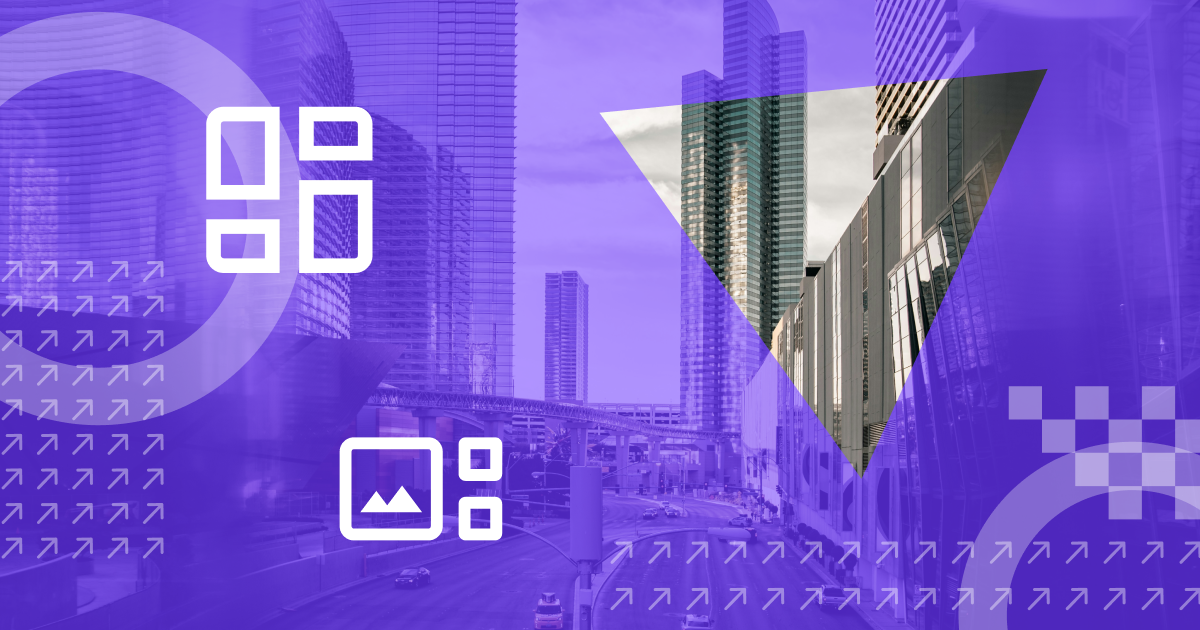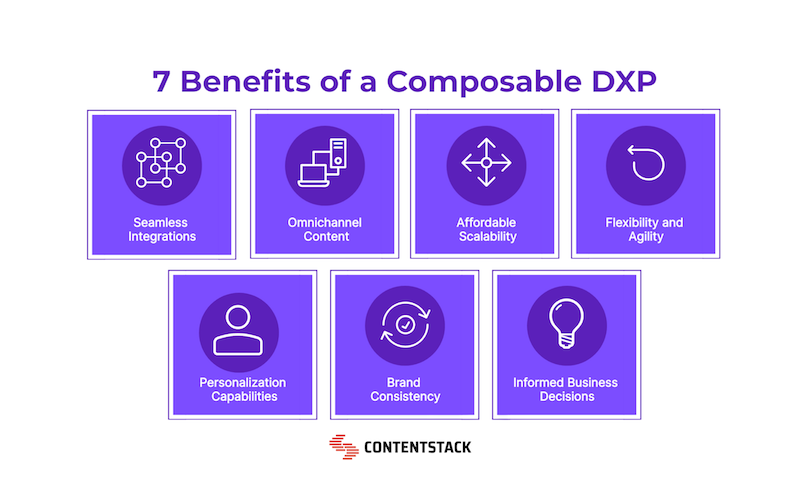Composable DXP: The key to effective digital transformation

Discover how a composable DXP can streamline your digital transformation. Learn about the benefits, best practices, and strategies to implement a composable DXP for your digital transformation initiatives. Take the steps to implement a composable DXP today. Request a free demo to get started.
Highlights
You’ll learn how composable DXPs streamline digital transformation
- Flexibility: Adapt to market shifts and emerging technologies
- Efficiency: Create seamless integrations for digital transformation
- Scalability: Expand your scope and take advantage of new opportunities
- User experience: Deliver personalized experiences that customers desire
- Cost-effective: You only pay for the resources you use, saving cost
Composable DXPs are agile and flexible, making them suitable for digital transformation. Start your journey to efficiency and excellence today! Request a free demo to see how it works.
Keep reading to learn more!
Digital transformation with composable DXP continues to gather pace. Driven by the need for flexible, scalable, and customized digital experiences, 74% of businesses now prioritize it, and Gartner reports 72% leadership involvement. Statista also adds that global spending on digital transformation could reach $4 trillion by 2027.
As these investments continue, the question remains: how does a composable DXP support digital transformation?
How composable DXPs facilitate digital transformation
A composable DXP breaks down monolithic systems into smaller, more flexible components. It does that with the help of APIs and microservices. That enables developers and digital marketers to work with any framework of choice, leading to more experimentation and faster development.
Here is an example. Wavin saw the slow digital transformation in the construction sector as an opportunity. They engaged Contentstack and opted for a composable DXP, allowing them to:
- Deliver world-class e-commerce features
- Increase the efficiency of their web shops
- Enter a new market—Indonesia.
That digital innovation effort boosted ordering speed by 50% and sped up their customer acquisition and onboarding.
Start your free trial with Contentstack today. Transform your brand's digital presence with Contentstack's open MACH architecture and industry-leading technology. Witness a significant reduction in publishing and development time, and elevate your content management. Start your free trial now.
Benefits of a composable DXP
While traditional DXPs are monolithic and inflexible, a composable DXP allows brands to select and integrate modules from different vendors. It relies on APIs and a modular approach to make that happen.
Also, components such as a headless CMS, CDPs, and CRM systems enhance the functionalities of composable DXPs. Here are key benefits of a composable digital experience platform (DXP).
More flexible and scalable
A composable DXP’s modular design allows businesses to scale individual modules independently. That enables them to adapt to changing demands and market shifts. With microservices and cloud solutions, businesses can scale their operations without disrupting the entire platform.
Faster innovation
Composable DXPs work with headless systems. They are not tied to specific vendors, frameworks or technologies. That decoupled approach allows developers to experiment with new technologies. That leads to faster iteration and release of new products and solutions.
Integrates with legacy systems
A true composable system is fluid. It integrates with existing legacy systems, extending their functionality and lifecycle. With a composable DXP, you do not need to replace your existing system, saving cost and ensuring you enjoy a seamless transition.
Supports personalized experiences
With analytics tools and customer data platforms (CDPs), businesses can collect, analyze, and make sense of customer data. That enables them to deliver tailored and engaging digital experiences.
Business agility
As businesses transform how they operate, a composable DXP is the perfect tool that allows them to adapt. They can replace old modules with newer, more relevant ones. That way, they can quickly adapt to new tech trends and market shifts.

How to implement a composable DXP for digital transformation
Going composable requires planning to ensure that all stakeholders are on board. Here are practical steps to implement a composable DXP for digital innovation.
Assess business needs
Understand why you need a composable DXP. You may want to achieve one or some of the following;
- Deliver omnichannel experiences
- Offer e-commerce services
- Speed up the release of new products and features
- Future-proof your digital transformation strategy
Identify what matters most to your business and to your customers. Identify operational and IT gaps and list out components to plug them.
Select the right tech stack
Choose a modular and scalable tech stack that also aligns with your business needs. Consider a headless CMS, microservices, API-first solutions, cloud-native solutions (MACH) and other essential DXP components.
Integrate microservices
Set up APIs and integrate microservices to ensure seamless data sharing between DXP components. Microservices break down monolithic systems into smaller, independent services, while APIs ensure these services stay in sync.
Set up data analytics tools
Set up data analytics tools to track system performance and customer interactions. That way, you can optimize system performance and tailor digital experiences to your customers' preferences.
Test and deploy
Test the system after integrating DXP modules and setting up analytics. As you integrate more modules, one or a few may not perform as expected—due to runtime errors or memory issues. Test for stress, load, and reliability, and fix any issues before the system goes live.
Contentstack: Your partner in scaling digital experiences. Twice named a Leader in Forrester's composable DXP award, Contentstack offers an innovative approach to DXP. Experience our 100% microservices architecture and API coverage that allows instant scalability. Start your free trial today.
Best practices for composable DXPs
A composable DXP is both a tech solution and a strategic tool that helps businesses change or improve their operations. Here are the best practices to consider.
- Adopt a modular approach: Right-size your DXP with the tools you need today while you future-proof your business. A modular approach allows you to swap out or replace solutions that no longer serve your business needs.
- Deploy cloud-native solutions: You get more resilience due to auto-scaling and abundant storage resources when you go cloud-native. So, you never run out of resources as you always have enough to handle traffic spikes.
- Optimize digital journeys: A recent report states that 51% of executives are prioritizing digital journeys. That is the way to go, as it helps you to understand the needs of your customers better and offer customer-centric solutions.
- Use analytics for personalized experiences: This recent report states that 62% of business leaders identified personalization as the key factor for customer retention. So, focus on using data to create the kind of experiences that customers desire.
- Monitor and improve: After your platform goes live, ensure you keep an eye on it. Also, track industry trends and know when to optimize the system or pivot, if required.
Future-proofing with DXPs
A composable DXP allows you to plug into the latest tech and market trends, making it ideal for future-proofing.
Digital innovation trends and their impact on DXPs
AI remains a major trend. Twilio reports that 92% of brands already use it to personalize digital experiences. Other trends like microservices and headless CMS have also become a key part of composable DXPs.
And thanks to cloud-native technology, DXPs have become more scalable and resilient. These trends, along with microservices, continue to shape composable DXPs.
The role of machine learning and AI
Machine learning algorithms analyze user interaction with brands and deliver insights via predictive analytics.
AI chatbots and virtual assistants have also improved customer service. Businesses can now respond to customer requests in real-time. AI also automates A/B testing, which helps brands adjust UI/UX for better user experiences.
Case studies
MongoDB
MongoDB was managing five core websites and multiple content management systems. The systems were not unified, so there was no business and IT alignment. Their systems also lacked design freedom and localization features.
They partnered with Contentstack and subscribed to the composable DXP with a headless CMS, and here is the result:
- Faster publishing speed across multiple channels
- 250+ pages migrated
- Translation support for seven languages
Hear from Subi Babu, the Engineering Lead at MongoDB. "Coming from an in-house CMS, our background for several years was focused on developing CMS features. Now, we can use the marketplace and get plug-and-play integrations, which is exciting."
Read more about how MongoDB powered digital modernization via a composable DXP.
Air France-KLM
Air France-KLM struggled with a legacy system that could not personalize, reuse or update content.
This is what Lydie Rodrigues, Solution Manager for Content, had to say. “Because of the complex architecture and our multichannel operations, content management had become a nightmare.”
They turned to Contentstack to solve these problems. The composable DXP allowed them to personalize content and digitalize the customer journey. It also reduced service line calls by 20%, translation costs by 20% and development costs by a projected 50%.
Listen to Ralf Schipper, the Product Owner CMS."With Contentstack, we are changing the way we distribute content, and paving the way for personalization. We’re defining the solution to master content distribution and optimize content creation and management."
Read the full story on how Air France-KLM streamlines content operations and omnichannel strategy on Contentstack.
FAQ Section
What is a composable DXP?
A composable DXP is a modular digital platform that allows businesses to integrate best-in-class modules and digital services that align with their business strategy.
What is the difference between a traditional DXP and a composable DXP?
A traditional DXP combines all solutions into one system under one roof. It is inflexible and vendor-dependent, while a composable DXP is modular and flexible, allowing you to integrate solutions from multiple vendors.
How can a composable DXP benefit my business?
A composable DXP allows you to adapt to new trends. You can iterate to deliver the best version of your products and services, and it adjusts to your needs as your business grows. Composable DXPs also support omnichannel delivery, making them ideal to deliver engaging customer experiences.
What are some best practices for implementing a composable DXP?
Some best practices would include adopting a modular approach, focusing on the improving customer experience and opting for cloud-native solutions. Also, tap into data analytics to optimize the platform and improve your digital services.
Learn more
There is a clear shift in customer demands, as most customers expect personalized experiences. That calls for brands to adapt or risk being left behind. Thankfully, a composable DXP offers the answers.
It is flexible, agile, and scalable. It supports your digital transformation and future-proofs your business technology. Opt for a composable DXP to succeed today and build for the future. Get started today. Request a demo to see how it works.
About Contentstack
The Contentstack team comprises highly skilled professionals specializing in product marketing, customer acquisition and retention, and digital marketing strategy. With extensive experience holding senior positions in notable technology companies across various sectors, they bring diverse backgrounds and deep industry knowledge to deliver impactful solutions.
Contentstack stands out in the composable DXP and Headless CMS markets with an impressive track record of 87 G2 user awards, 6 analyst recognitions, and 3 industry accolades, showcasing its robust market presence and user satisfaction.
Check out our case studies to see why industry-leading companies trust Contentstack.
Experience the power of Contentstack's award-winning platform by scheduling a demo, starting a free trial, or joining a small group demo today.
Follow Contentstack on Linkedin
Recommended posts



.svg?format=pjpg&auto=webp)


.svg?format=pjpg&auto=webp)
.svg?format=pjpg&auto=webp)
.svg?format=pjpg&auto=webp)
.svg?format=pjpg&auto=webp)







